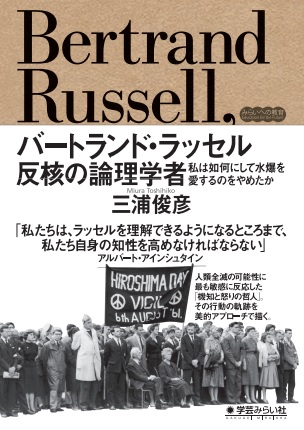
Title
Education for the Future series Bertrand Russell Hankaku no Ronrigakusha (Bertrand Russell, The Anti-nuclear Logician - How I Learned to Stop Loving the Bomb)
Size
304 pages, A5 format
Language
Japanese
Released
July 23, 2019
ISBN
978-4909783134
Published by
Gakugei Miraisha
Book Info
See Book Availability at Library
Japanese Page
British mathematician Bertrand Russell (1872–1970), renowned for the “Russell’s paradox” that shook the foundations of mathematics in the early 20th century, tackled various problems in traditional philosophy using symbolic logic, which he developed himself to reconstruct mathematics, and became the founder of the so-called “analytic philosophy.” He was also popular as a writer of bestsellers on theories of life, such as happiness and marriage.
As an undergraduate, I was fascinated by this mathematician-philosopher and his accomplishments, which were comparable in number to those of several historical figures combined. I was impressed by not only the content of his theoretical philosophy and social thought but also his personality. Russell, who was fired from his teaching position at Cambridge University and even imprisoned for his anti-war activities during World War I, recalled that the war had been like Mephistopheles for him. He saw in himself Faust, unleashed from the academic circles into the real world by the devil.
In my eyes, however, Russell was more like Don Quixote—not as a ridiculous clown, but as a saint in innocent pursuit of his ideals. After the “Russell-Einstein Manifesto” (1955), which he published the year after the Bikini H-bomb test, Russell, who was at the forefront of the anti-nuclear peace movement, clashed with the Western establishment and was imprisoned again at the age of 89, but his activities did not affect the political reality of nuclear strategy; the words and deeds of this old philosopher circulated only as a symbol of anti-war passions without any practical power.
This way of being of Russell resembles a work of art. I therefore decided to study his life as a phenomenon in itself, in terms of its aesthetic atmosphere, rather than its influence or ideological significance.
Thus, this book is an attempt to portray Russell’s duality through a comparison of two literary characters in the manner of interpreting an artwork—the altruistic Don Quixote who devotes his life to world peace and the selfish Faust who gains fulfillment by immersing himself in enthusiastic anti-war demonstrations. The life torn by these contrasting impulses is interesting on its own, but to grasp the character in a multilayered way, I introduced another interpretation axis: “The relationship between Russell and Japan.”
Russell came to Japan in 1921 at the invitation of the magazine “Kaizo” and caused a stir in Japanese academic and thought circles; in his eyes though, Japan was a potential threat to world peace. However, after World War II, Russell looked to the atomic-bombed nation as a base for the peace movement, and was in deep solidarity with Japanese peace organizations. This transition in Russell’s relationship with Japan, over the course of more than 40 years, seems to show the conflict and harmony created by emotions common to all people.
This book is the master’s thesis I submitted to the Graduate School of Arts and Sciences at the University of Tokyo in 1984. To publish it, it was meaningful for me to retrace the anguish of the great philosopher who feared humanity’s annihilation during the Cold War, in terms of my own self-reflection and self-discovery. Today, after the Fukushima disaster and COVID-19 outbreak, the meaning of “world peace” has changed, and I believe that appreciating Russell’s life will help us rediscover lost perspectives.
(Written by MIURA Toshihiko, Professor, Graduate School of Humanities and Sociology / 2021)



 Find a book
Find a book

